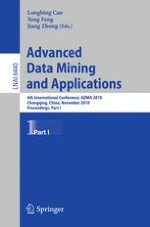With the ever-growing power of generating, transmitting, and collecting huge amounts of data, information overloadis nowan imminent problemto mankind. The overwhelming demand for information processing is not just about a better understanding of data, but also a better usage of data in a timely fashion. Data mining, or knowledge discovery from databases, is proposed to gain insight into aspects ofdata and to help peoplemakeinformed,sensible,and better decisions. At present, growing attention has been paid to the study, development, and application of data mining. As a result there is an urgent need for sophisticated techniques and toolsthat can handle new ?elds of data mining, e. g. , spatialdata mining, biomedical data mining, and mining on high-speed and time-variant data streams. The knowledge of data mining should also be expanded to new applications. The 6th International Conference on Advanced Data Mining and Appli- tions(ADMA2010)aimedtobringtogethertheexpertsondataminingthrou- out the world. It provided a leading international forum for the dissemination of original research results in advanced data mining techniques, applications, al- rithms, software and systems, and di?erent applied disciplines. The conference attracted 361 online submissions from 34 di?erent countries and areas. All full papers were peer reviewed by at least three members of the Program Comm- tee composed of international experts in data mining ?elds. A total number of 118 papers were accepted for the conference. Amongst them, 63 papers were selected as regular papers and 55 papers were selected as short papers.
